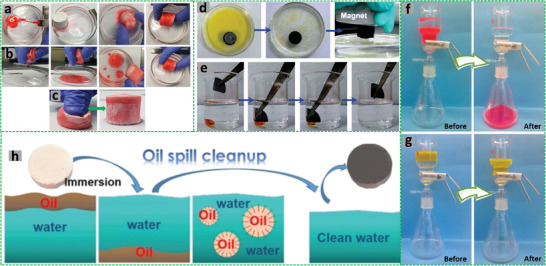Figure 18.

Photographs demonstrate a) sorption/compression/resorption, b) recovery, and again resorption of the crude oil from oil–water mixture by using emulsion‐templated covalently bonded silica−polymer composites, and c) flexible/compressible nature of the adsorbent. A red dye is added into the crude oil for easy observation. Reproduced under a Creative Commons Attribution 4.0.[ 190 ] Copyright 2017, The Authors(s), published by Springer Nature. Photographs show the removal of d) diesel and e) tetrachloromethane (stained with Sultan VI) from water. Reproduced under a Creative Commons Attribution‐NonCommercial 3.0 Unported Licence.[ 196 ] Copyright, The Author(s), published by the Royal Society of Chemistry. Images of CO2‐controlled O/W separation. Separation of f) water/chloroform (red) using dried membrane and g) water/hexane (yellow) by CO2‐treated membrane. Reproduced with permission.[ 119 ] Copyright 2017, American Chemical Society. h) Schematics illustrates oil absorption from water surface, underwater oil, and emulsified oil by SPS monolith. Reproduced with permission.[ 112 ] Copyright 2019, American Chemical Society.
